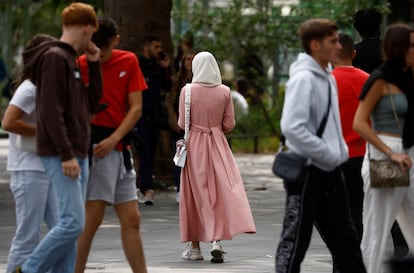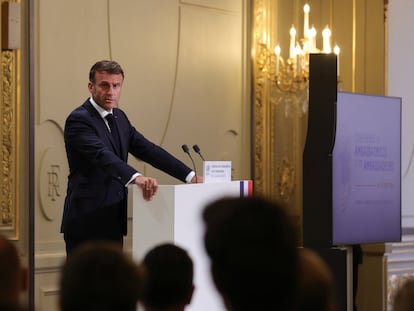The abaya triggers a new battle for secularism in France
The banning of the tunic marks the start of the political and school year even though the wearing of the garment is increasingly rare

Noise in the political sphere, calm in the classroom. The ban on the abaya, the traditional tunic in some Muslim countries, considered an indication of religious or cultural identity, has come into force this week in French schools amid an intense debate on secularism and its application in the education system. The Council of State must decide by September 7 whether the measure is legal and respects fundamental freedoms.
So rare is the wearing of the garment that the law appears to be addressing an issue that is all but anecdotal. Of the 12 million French pupils who returned to school on Monday, 298 arrived wearing the abaya and 67 refused to remove it, and were consequently sent home, according to provisional figures from France’s Ministry of Education which banned the Islamic veil and any other garment or accessory with religious connotations, from the Christian cross to the Jewish skull cap, in 2004.
“Outside of the classroom, pupils have the right to dress as they want,” says Christine Guimonnet, a history and geography teacher at the Lycée Camille Pissarro in Pontoise, north of Paris. “But, when they come to class, they cannot wear clothes that indicate a religious affiliation.” At her high school, Guimonnet has not experienced any cases of pupils wearing the abaya this week; last year she had to tell one student to take it off.
Until now, the guidelines on the wearing of the abaya have been vague and decisions on whether the abaya and qamis fell under the 2004 law as a piece of clothing that indicates a religious or cultural identity have been left to the teachers’ discretion. But the garment — equivalent to the even less common qamis for boys — appears to be gaining popularity among French Muslim girls.
The October 2020 murder of teacher Samuel Paty, who was subjected to a hate campaign after showing caricatures of the Prophet Mohammed in class, flagged up what was perceived as an Islamist threat in schools. Now the French government’s decision on the abaya relieves school principals from making any decision on the issue themselves and thereby prevents exposure to a potential backlash.
Secular education, a pillar of the Republic
In France, secular and centralized education is considered one of the pillars of the Republic. It is the engine of meritocracy, although it often fails in its democratizing role, and even exacerbates inequalities. This secular sanctuary can, in fact, feel besieged by religion. Just over a century ago, when secularism was introduced into law in 1905, the perceived threat was Catholicism; now it is Islam.
The 2004 law states that the Republic guarantees freedom of conscience and the freedom to exercise any religion; at the same time, the State does not recognize or subsidize any religion. Partly in response to the proliferation of Islamic veils in classrooms, the 2004 law prohibited the wearing of anything “by which pupils ostensibly indicate a religious affiliation.”
But, according to Muslim representatives, the abaya, which originated in the Persian Gulf region, is more cultural than religious. Besides, there is no simple definition of this long tunic. So, when it is not clear whether it is an abaya or not, the question is whether a decision would be made depending on the student’s beliefs.
“Once again, we know that Muslims are being targeted,” says Jean-Luc Mélenchon, leader of La France Insumée, a left-wing political party. The feminist ecologist Sandrine Rousseau believes that the measure imposes “social control over the bodies of women and girls.”
Division on the left
But there is another perspective on the left, especially among socialists and communists, who favor the banning of the abaya in the name of secularism, which is historically associated with progressive values. Meanwhile, the right and the extreme right applaud the ban.
In the 2022-2023 school year, the number of reported challenges to secularism in schools increased by 120% compared to the previous school year, according to figures cited by Le Monde. Forty percent of the incidents concerned clothing, but were confined to a very small number of middle and secondary schools — about 150 of the 10,000 in France.
The Minister of Education, Gabriel Attal, considers that by promoting the abaya, Islamists “put the Republic to the test.” According to Guimonnet, who has extensive hands-on experience in dealing with these issues: “It is not a ban to prevent the students from being who they are, but the high school is not a place to display their religion: the student should not disappear behind the belief.”
Philosophy professor and secularism specialist Henri Peña-Ruiz agrees: “The 2004 law removes all religious proselytism from schools,” he says. “It also applies to atheist proselytism: a child wearing a T-shirt saying ‘God does not exist’ or ‘God is dead,’ as Nietzsche said, would not be allowed. The school has to provide common ground. It is not a place for religious struggle, but of serene study. In France, we are experiencing a significant attack from the Islamists, who try, by any means, to impose their religious customs,” he adds.
As a man with communist sympathies, Peña-Ruiz is uncomfortable with the position of others on the left: “Many people on the left are condescending,” he says. “They imagine that Muslims are the new proletariat, and say, ‘What are we doing to the poor Muslims?’ I always reply that Muslims should not be treated like this as it is, in the end, humiliating; they are human beings like everyone else.”
Jean Baubérot, another specialist in secularism with left-leaning politics, disagrees: “There has always been a temptation, among certain left-wing sympathizers, to be anti-religious, but it turns out that in France secularism is not anti-religious. The abaya is originally a traditional Bedouin dress, not a religious one. It is strange that, in a secular Republic, it is the minister who says what is religious and what is not.” He adds that when the veil was banned in 2004, teenagers sought ways to get around the ban by wearing alternatives: hence the abaya. He believes the same will happen now. “It’s like a game of cat and mouse,” he says. “The State is turning generations of people against secularism, because they are presented with a truncated form of it.”
But Guimonnet points out that when students question her about the restrictions associated with secularism, she tells them that she, as an employee of the State, also has to respect certain boundaries: for example, she is not allowed to influence them politically. “The school is first and foremost a secular ‘breathing’ space, where students can temporarily set aside their beliefs — a place of emancipation through knowledge,” she says.
Sign up for our weekly newsletter to get more English-language news coverage from EL PAÍS USA Edition
Tu suscripción se está usando en otro dispositivo
¿Quieres añadir otro usuario a tu suscripción?
Si continúas leyendo en este dispositivo, no se podrá leer en el otro.
FlechaTu suscripción se está usando en otro dispositivo y solo puedes acceder a EL PAÍS desde un dispositivo a la vez.
Si quieres compartir tu cuenta, cambia tu suscripción a la modalidad Premium, así podrás añadir otro usuario. Cada uno accederá con su propia cuenta de email, lo que os permitirá personalizar vuestra experiencia en EL PAÍS.
¿Tienes una suscripción de empresa? Accede aquí para contratar más cuentas.
En el caso de no saber quién está usando tu cuenta, te recomendamos cambiar tu contraseña aquí.
Si decides continuar compartiendo tu cuenta, este mensaje se mostrará en tu dispositivo y en el de la otra persona que está usando tu cuenta de forma indefinida, afectando a tu experiencia de lectura. Puedes consultar aquí los términos y condiciones de la suscripción digital.
More information
Archived In
Últimas noticias
There is as much life left to discover on planet Earth as that which is already known
Dozens presumed dead, around 100 injured in fire at Swiss Alps bar during New Year’s celebration
Is porn for women different from conventional porn? We spoke to those who make it
Cartagena de Indias is sinking: What can the city do to mitigate it?
Most viewed
- Reinhard Genzel, Nobel laureate in physics: ‘One-minute videos will never give you the truth’
- Sinaloa Cartel war is taking its toll on Los Chapitos
- David King, chemist: ‘There are scientists studying how to cool the planet; nobody should stop these experiments from happening’
- Oona Chaplin: ‘I told James Cameron that I was living in a treehouse and starting a permaculture project with a friend’
- The Interoceanic Train, the Mexican alternative to the Panama Canal











































